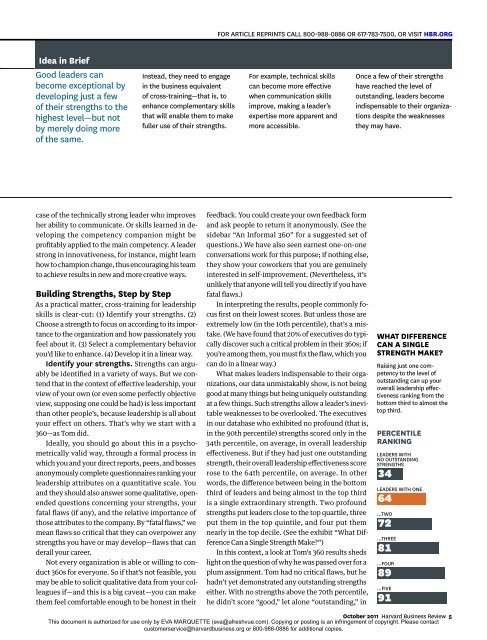W2 CELP Making Yourself Indispensable
You also want an ePaper? Increase the reach of your titles
YUMPU automatically turns print PDFs into web optimized ePapers that Google loves.
For article reprints call 800-988-0886 or 617-783-7500, or visit hbr.org<br />
Idea in Brief<br />
Good leaders can<br />
become exceptional by<br />
developing just a few<br />
of their strengths to the<br />
highest level—but not<br />
by merely doing more<br />
of the same.<br />
Instead, they need to engage<br />
in the business equivalent<br />
of cross-training—that is, to<br />
enhance complementary skills<br />
that will enable them to make<br />
fuller use of their strengths.<br />
For example, technical skills<br />
can become more effective<br />
when communication skills<br />
improve, making a leader’s<br />
expertise more apparent and<br />
more accessible.<br />
Once a few of their strengths<br />
have reached the level of<br />
outstanding, leaders become<br />
indispensable to their organizations<br />
despite the weaknesses<br />
they may have.<br />
case of the technically strong leader who improves<br />
her ability to communicate. Or skills learned in developing<br />
the competency companion might be<br />
profitably applied to the main competency. A leader<br />
strong in innovativeness, for instance, might learn<br />
how to champion change, thus encouraging his team<br />
to achieve results in new and more creative ways.<br />
Building Strengths, Step by Step<br />
As a practical matter, cross-training for leadership<br />
skills is clear-cut: (1) Identify your strengths. (2)<br />
Choose a strength to focus on according to its importance<br />
to the organization and how passionately you<br />
feel about it. (3) Select a complementary behavior<br />
you’d like to enhance. (4) Develop it in a linear way.<br />
Identify your strengths. Strengths can arguably<br />
be identified in a variety of ways. But we contend<br />
that in the context of effective leadership, your<br />
view of your own (or even some perfectly objective<br />
view, supposing one could be had) is less important<br />
than other people’s, because leadership is all about<br />
your effect on others. That’s why we start with a<br />
360—as Tom did.<br />
Ideally, you should go about this in a psychometrically<br />
valid way, through a formal process in<br />
which you and your direct reports, peers, and bosses<br />
anonymously complete questionnaires ranking your<br />
leadership attributes on a quantitative scale. You<br />
and they should also answer some qualitative, openended<br />
questions concerning your strengths, your<br />
fatal flaws (if any), and the relative importance of<br />
those attributes to the company. By “fatal flaws,” we<br />
mean flaws so critical that they can overpower any<br />
strengths you have or may develop—flaws that can<br />
derail your career.<br />
Not every organization is able or willing to conduct<br />
360s for everyone. So if that’s not feasible, you<br />
may be able to solicit qualitative data from your colleagues<br />
if—and this is a big caveat—you can make<br />
them feel comfortable enough to be honest in their<br />
feedback. You could create your own feedback form<br />
and ask people to return it anonymously. (See the<br />
sidebar “An Informal 360” for a suggested set of<br />
questions.) We have also seen earnest one-on-one<br />
conversations work for this purpose; if nothing else,<br />
they show your coworkers that you are genuinely<br />
interested in self-improvement. (Nevertheless, it’s<br />
unlikely that anyone will tell you directly if you have<br />
fatal flaws.)<br />
In interpreting the results, people commonly focus<br />
first on their lowest scores. But unless those are<br />
extremely low (in the 10th percentile), that’s a mistake.<br />
(We have found that 20% of executives do typically<br />
discover such a critical problem in their 360s; if<br />
you’re among them, you must fix the flaw, which you<br />
can do in a linear way.)<br />
What makes leaders indispensable to their organizations,<br />
our data unmistakably show, is not being<br />
good at many things but being uniquely outstanding<br />
at a few things. Such strengths allow a leader’s inevitable<br />
weaknesses to be overlooked. The executives<br />
in our database who exhibited no profound (that is,<br />
in the 90th percentile) strengths scored only in the<br />
34th percentile, on average, in overall leadership<br />
effectiveness. But if they had just one outstanding<br />
strength, their overall leadership effectiveness score<br />
rose to the 64th percentile, on average. In other<br />
words, the difference between being in the bottom<br />
third of leaders and being almost in the top third<br />
is a single extraordinary strength. Two profound<br />
strengths put leaders close to the top quartile, three<br />
put them in the top quintile, and four put them<br />
nearly in the top decile. (See the exhibit “What Difference<br />
Can a Single Strength Make?”)<br />
In this context, a look at Tom’s 360 results sheds<br />
light on the question of why he was passed over for a<br />
plum assignment. Tom had no critical flaws, but he<br />
hadn’t yet demonstrated any outstanding strengths<br />
either. With no strengths above the 70th percentile,<br />
he didn’t score “good,” let alone “outstanding,” in<br />
What Difference<br />
can a Single<br />
Strength Make?<br />
Raising just one competency<br />
to the level of<br />
outstanding can up your<br />
overall leadership effectiveness<br />
ranking from the<br />
bottom third to almost the<br />
top third.<br />
percentile<br />
ranking<br />
leaders with<br />
no outstanding<br />
strengths<br />
34<br />
leaders with one<br />
64<br />
...Two<br />
72<br />
...three<br />
81<br />
...four<br />
89<br />
...five<br />
91<br />
October 2011 Harvard Business Review 5<br />
This document is authorized for use only by EVA MARQUETTE (eva@afreshvue.com). Copying or posting is an infringement of copyright. Please contact<br />
customerservice@harvardbusiness.org or 800-988-0886 for additional copies.



